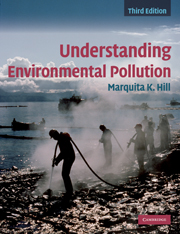Book contents
- Frontmatter
- Contents
- Preface
- Acknowledgements
- List of abbreviations and acronyms
- 1 Understanding pollution
- 2 Reducing risk, reducing pollution
- 3 Chemical toxicity
- 4 Chemical exposures and risk assessment
- 5 Air pollution
- 6 Acid deposition
- 7 Global climate change
- 8 Stratospheric ozone depletion
- 9 Water pollution
- 10 Drinking-water pollution
- 11 Solid waste
- 12 Hazardous waste
- 13 Energy
- 14 Persistent, bioaccumulative, and toxic
- 15 Metals
- 16 Pesticides
- 17 Pollution at home
- 18 Zero waste, zero emissions
- 19 Chemistry: some basic concepts
- Index
- References
10 - Drinking-water pollution
Published online by Cambridge University Press: 05 June 2012
- Frontmatter
- Contents
- Preface
- Acknowledgements
- List of abbreviations and acronyms
- 1 Understanding pollution
- 2 Reducing risk, reducing pollution
- 3 Chemical toxicity
- 4 Chemical exposures and risk assessment
- 5 Air pollution
- 6 Acid deposition
- 7 Global climate change
- 8 Stratospheric ozone depletion
- 9 Water pollution
- 10 Drinking-water pollution
- 11 Solid waste
- 12 Hazardous waste
- 13 Energy
- 14 Persistent, bioaccumulative, and toxic
- 15 Metals
- 16 Pesticides
- 17 Pollution at home
- 18 Zero waste, zero emissions
- 19 Chemistry: some basic concepts
- Index
- References
Summary
“The wall between us and microbes, is beginning to crumble.”
American Academy of MicrobiologyMost of us in developed countries take clean and plentiful water as a given, not just drinking water, but water for household, yard, and other uses. Yet, says the American Academy of Microbiology, “Microbiologically safe drinking water can no longer be assumed, even in the United States and other developed countries, and the situation will worsen unless measures are taken in the immediate future – the crisis is global.” Treating drinking water to kill pathogens is given much credit for increasing the life span of US people from 47 years at the turn of the twentieth century to 77 years. But the twenty-first century begins with a fifth of humanity still without clean drinking water. Even poor-quality water is becoming scarcer and even scarcer for sanitary needs. ▪ The UN estimates that in the near future, at least 40% of the world's people will live in countries where they cannot get enough water to satisfy basic needs. Wildlife is increasingly deprived of water. Domestic animals may go wanting. Demand for fresh water increased six-fold in the twentieth century, more than twice the rate of population growth. Reasons for water scarcity include an increasing human population that wants and needs more water. Industrial use of water has increased. However, most of the increased water use has arisen from irrigating farm land.
- Type
- Chapter
- Information
- Understanding Environmental Pollution , pp. 286 - 310Publisher: Cambridge University PressPrint publication year: 2010



